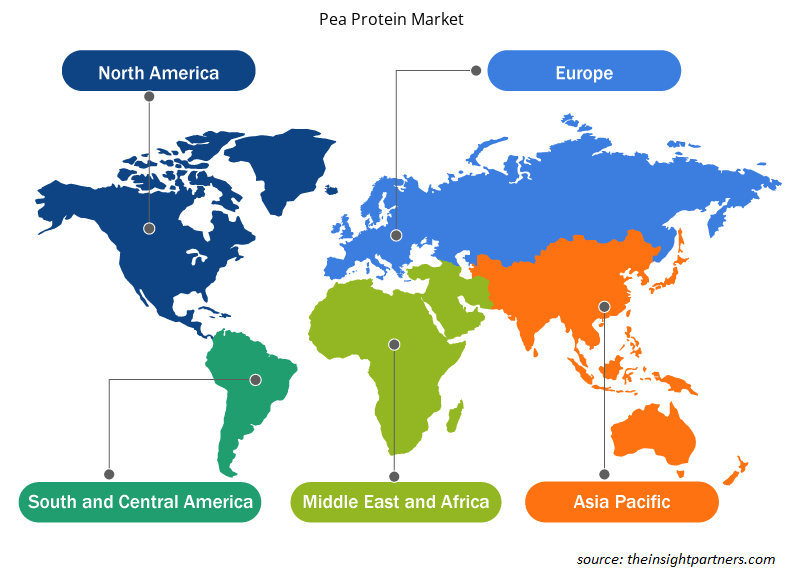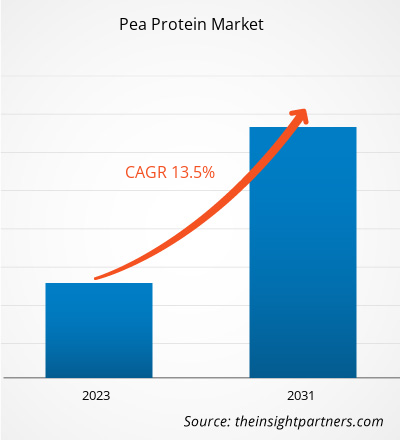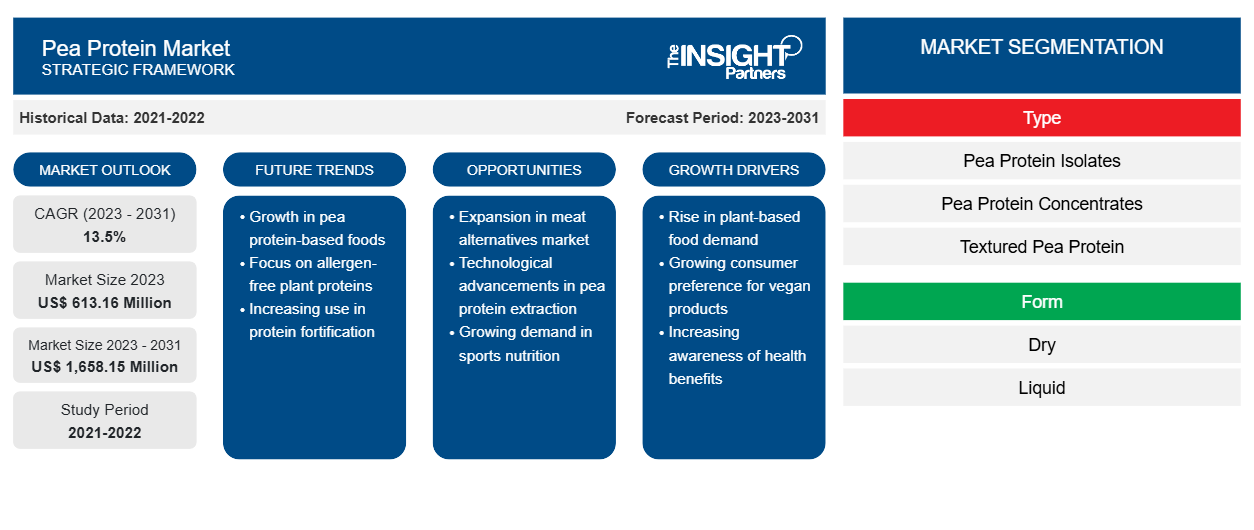豌豆蛋白市场规模预计将从 2023 年的 6.1316 亿美元增至 2031 年的 16.5815 亿美元。预计 2023-2031 年市场复合年增长率将达到 13.5%。豌豆蛋白作为宠物食品和动物饲料中蛋白质来源的销量旺盛可能仍是豌豆蛋白市场的主要趋势。
豌豆蛋白市场分析
由于人们健康意识增强、多种健康益处以及对肉类蛋白质替代品的需求增加等因素,豌豆蛋白市场正在以显著的速度增长。此外,在各种产品中使用豌豆蛋白的趋势、食品和饮料行业的持续增长、对有机食品的需求增加以及蛋白质产品的创新等因素也促进了全球豌豆蛋白市场的增长。越来越多的消费者寻求更简单的标签、更好的口味和替代蛋白质来源来解决个性化的营养选择,这反过来可能会加速豌豆蛋白市场的增长。然而,替代蛋白质的可用性和消费者对豌豆蛋白产品的低认知度可能会限制预测期内市场的增长。
豌豆蛋白市场概况
豌豆蛋白是从绿豌豆和黄豌豆中提取的,主要用于制作蛋白粉。它通常用作素食汉堡、纯素蛋黄酱等包装食品的原料,甚至替代一些冰淇淋和牛奶中的乳制品。豌豆蛋白是铁的极佳来源。它被添加到冰沙和奶昔等食品中以增加蛋白质含量,而且由于它是天然的纯素和低过敏性,因此也非常适合几乎任何饮食。豌豆蛋白含有人体无法产生的九种必需氨基酸。
定制此报告以满足您的需求
您可以免费定制任何报告,包括本报告的部分内容、国家级分析、Excel 数据包,以及为初创企业和大学提供优惠和折扣
-
获取此报告的关键市场趋势。这个免费样品将包括数据分析,从市场趋势到估计和预测。
豌豆蛋白市场驱动因素和机遇
膳食补充剂需求增加,市场前景看好
豌豆蛋白用于营养保健品,如膳食和健康补充剂,以及用于消化健康。膳食补充剂以片剂、胶囊、药丸或液体的形式口服。膳食补充剂是含有矿物质、维生素、草药或其他植物药或氨基酸的食品。豌豆蛋白被引入膳食补充剂中,以便为消费者提供维生素、矿物质、纤维和其他必需成分的外部来源。消费者对这些膳食补充剂的需求不断增长,推动了市场的增长。
对豌豆蛋白类运动营养品和其他健康产品的需求不断增长
豌豆蛋白具有乳化、质地增强和发泡等多种功能特性,扩大了其市场潜力。市场主要参与者正在积极开发使用豌豆蛋白的产品,以满足消费者的需求。
豌豆蛋白市场报告细分分析
有助于豌豆蛋白市场分析的关键部分是类型、形式和应用。
- 根据类型,豌豆蛋白市场分为豌豆分离蛋白、豌豆浓缩蛋白、组织豌豆蛋白。
- 从形式上看,市场分为干市场和液态市场。
- 在应用方面,市场分为膳食补充剂、烘焙和糖果食品、肉类替代品、饮料等。
豌豆蛋白市场份额按地区分析
豌豆蛋白市场报告的地理范围主要分为五个地区:北美、亚太、欧洲、中东和非洲、南美/南美和中美。
北美主导着豌豆蛋白市场。由于对健康生活方式的关注度不断提高,消费者对非肉类替代品的兴趣日益浓厚,这使得北美制造商能够加入高品质的植物性成分。环境问题的增加和对动物福利意识的提高使人们的注意力转向了从植物蛋白中提取的替代蛋白质。预计亚太地区将在未来几年以最高的复合年增长率增长。
豌豆蛋白市场区域洞察
Insight Partners 的分析师详细解释了预测期内影响豌豆蛋白市场的区域趋势和因素。本节还讨论了北美、欧洲、亚太地区、中东和非洲以及南美和中美洲的豌豆蛋白市场细分和地理位置。

- 获取豌豆蛋白市场的区域特定数据
豌豆蛋白市场报告范围
| 报告属性 | 细节 |
|---|---|
| 2023 年的市场规模 | 6.1316亿美元 |
| 2031 年市场规模 | 16.5815亿美元 |
| 全球复合年增长率(2023 - 2031) | 13.5% |
| 史料 | 2021-2022 |
| 预测期 | 2023-2031 |
| 涵盖的领域 |
按类型
|
| 覆盖地区和国家 |
北美
|
| 市场领导者和主要公司简介 |
|
豌豆蛋白市场参与者密度:了解其对业务动态的影响
豌豆蛋白市场正在快速增长,这得益于终端用户需求的不断增长,而这些需求又源于消费者偏好的不断变化、技术进步以及对产品优势的认识不断提高等因素。随着需求的增加,企业正在扩大其产品范围,进行创新以满足消费者的需求,并利用新兴趋势,从而进一步推动市场增长。
市场参与者密度是指在特定市场或行业内运营的企业或公司的分布情况。它表明相对于给定市场空间的规模或总市场价值,有多少竞争对手(市场参与者)存在于该市场空间中。
在豌豆蛋白市场运营的主要公司有:
- A&B Ingredients 和 Axiom Foods, Inc.
- Burcon 营养科学公司
- 南非科苏克拉集团
- 盖美夫工业公司
- 哥兰比亚营养品
- Puris、Roquette Freres
免责声明:上面列出的公司没有按照任何特定顺序排列。

- 了解豌豆蛋白市场顶级关键参与者概况
豌豆蛋白市场新闻和最新发展
豌豆蛋白市场通过收集一级和二级研究后的定性和定量数据进行评估,其中包括重要的公司出版物、协会数据和数据库。以下是言语和语言障碍市场的发展和策略列表:
- 2023 年 1 月,食品和饮料植物蛋白开发领域的全球技术领导者 Burcon NutraScience Corporation 欣然宣布,该公司已收到美国专利商标局 (USPTO) 的授权通知,该申请涵盖了 Burcon 独特工艺生产的 Peazazz® 豌豆蛋白的特性。美国专利商标局的授权通知是一种书面通知,表明专利申请已通过内部审查,正在等待发布,并将在不久的将来获得授权。(来源:Burcon NutraScience Corporation,新闻稿/公司网站/时事通讯,2023 年)
豌豆蛋白市场报告覆盖范围和交付成果
“豌豆蛋白市场规模和预测(2021-2031)”报告对市场进行了详细的分析,涵盖以下领域:
- 范围内所有主要细分市场的全球、区域和国家层面的市场规模和预测
- 市场动态,如驱动因素、限制因素和关键机遇
- 未来主要趋势
- 详细的 PEST/波特五力分析和 SWOT 分析
- 全球和区域市场分析涵盖关键市场趋势、主要参与者、法规和最新市场发展
- 行业格局和竞争分析,涵盖市场集中度、热点图分析、知名参与者和最新发展
- 详细的公司简介
- 历史分析(2 年)、基准年、预测(7 年)及复合年增长率
- PEST和SWOT分析
- 市场规模、价值/数量 - 全球、区域、国家
- 行业和竞争格局
- Excel 数据集
近期报告
客户评价
购买理由
- 明智的决策
- 了解市场动态
- 竞争分析
- 客户洞察
- 市场预测
- 风险规避
- 战略规划
- 投资论证
- 识别新兴市场
- 优化营销策略
- 提升运营效率
- 顺应监管趋势























 获取免费样品 - 豌豆蛋白市场
获取免费样品 - 豌豆蛋白市场